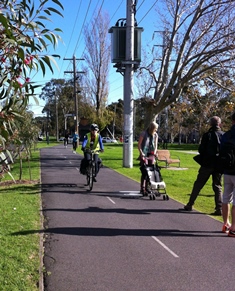Shared paths - issues and solutions
22 Jun 2015
New research from Victoria Walks suggests a move to separated walking and cycling paths.
Victoria Walks have developed a comprehensive research paper, Shared paths – the issues, based on a literature review and stakeholder consultation with subject experts, VicRoads and 18 local councils. The research provides the basis for our short position statement Shared paths – finding solutions.
The research paper and position statement set out options and recommendations for infrastructure that work for both walkers and cyclists.
Some key points coming out of the research include:
- Cycling speed varies considerably between cyclists and paths, but typically averages between 20 and 30 km/h.
- Shared paths with high volumes of cyclists (more than 50 per hour in the commuter peak) should be identified for separation/segregation; or consider options where cyclists can safely ride on roads.
- Where existing shared paths cannot be separated/segregated, public education and signage should aim to establish a culture of sharing paths by users, emphasising that shared paths should be low speed and that cyclists are legally required to give way to walkers.
- Road managers should avoid converting footpaths to shared paths, as they may be ‘designing out’ the most vulnerable road users – older walkers and those with a disability.
- In new suburbs, cyclists should be provided with dedicated cycling paths or safe on-road cycling conditions and walkers with footpaths, rather than shared paths.